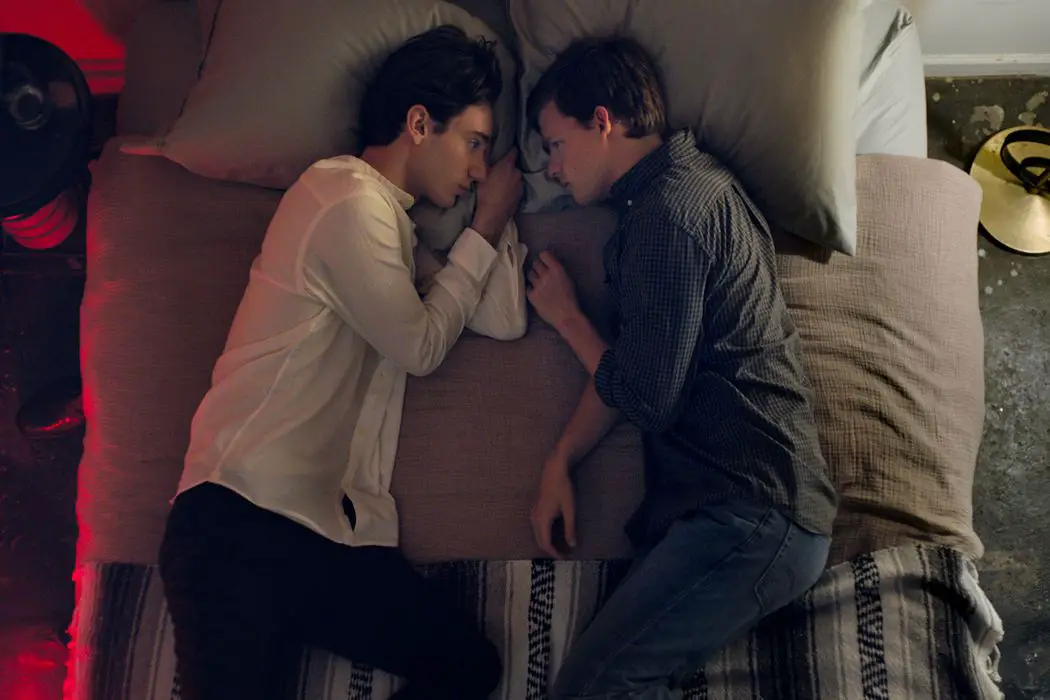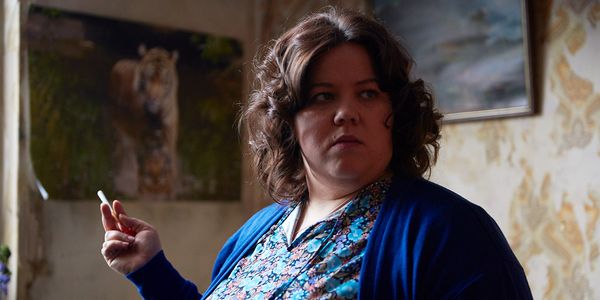Toronto International Film Festival 2018 Report Part 3: Lucas Hedges His Bets

Tomas is a chronic cineaste who studied English literature in…
My third day of Toronto International Film Festival brought some pleasant surprises and one particularly unfortunate disappointment. Oh, and if you didn’t know by now, I got my fill of Lucas Hedges, who starred in two of the four films I’ll review for you right now:
Ray & Liz (Richard Billingham)

Richard Billingham is best known as a photographer. His first monograph collection, Ray’s a Laugh, depicted Billingham’s parents, Ray and Liz, in what could be said to be an unflattering light: often drunk, indigent, or immobile. More than two decades after the fact, he has now recreated those photographs in his debut feature, a work of surprising dexterity and sincerity that seeks compatibility between a critical eye of the past and a nostalgic one. Moving between three time periods, Billingham casts lookalike actors Justin Salinger and Ella Smith as his titular parents and has them find an unusual middle ground between stasis and action. In other words, a middle ground between doing very little and finding a wellspring of meaning within that inactivity.
It works, and often beautifully. Billingham has a clear vision from the outset, letting his camera rove around the shabby rooms which Ray and Liz inhabit and focusing on the minutiae peppering their reality: buzzing flies, glittering bottles of homebrew and liquor, cheap jigsaw puzzles, worn-out settees, jars of pickled red cabbage and used cigarettes collected from sidewalks and tube stations. This collective bric-a-brac, and how Ray and Liz manipulate these objects within their personal space, ends up revealing the very prison that is impoverished living—more so than any shrill rant or long string of expletives can.
During the Q&A, in fact, Smith revealed that Billingham instructed her to pass a cigarette very slowly, because it was a deliberate way for Liz to fill out the long stretch of her day. And that is the essence of this film’s beauty: it focuses on those kinds of imperceptible actions that end up accruing a larger meaning the more the film documents them. The use of 16mm adds a textured richness to these perceptions of space and movement, so that the peeling wallpaper and soiled furniture of the couple’s council flat have a greater immediacy while still remaining somewhere off in the distance, in a dreamlike state of not-being reminiscent of Terence Davies and his conception of the past as a network of fluid movement and tactile referentiality.
If there is a difference between Davies and Billingham, it’s that the latter’s remembrances are not colored by anything resembling fondness. He makes it very clear that his parents were ineffective caregivers, and that his maturity into adulthood was a quick one. Yet this work does not exploit them, either. They were the products of their economic condition, and Billingham understands that they did not know how to deal with it effectually. They were, in a way, as lost as he once was, and by giving them new life through this film, he can finally show them the way to freedom, and thereby peace.
Boy Erased (Joel Edgerton)

Based on a 2016 memoir by Garrard Conley, Boy Erased isn’t the first film this year to deal with the destructive practice of conversion therapy (that would be Desiree Akhavan’s The Miseducation of Cameron Post). This is sensitive territory for the LGBTQ community, as the psychological trauma and harm caused by these therapies has been wide-reaching. Nor is it fully outlawed. Queer men and women are still being subjected to this unspeakable cruelty, many by members of their own family who believe their fundamental humanity can be altered. We know this isn’t true. Yet the suffering persists unabated. That’s why films like Cameron Post and Boy Erased are vital calls to action, educating people about the true costs for the parties involved with the hope that more can be done to have the therapy vanquished entirely.
What disappoints me about Boy Erased’s approach, though, is how anemic it comes across. Everything is very orderly and uncomplicated, with every character getting a proper little introduction, and every flashback giving the proper context for the present-day action. Joel Edgerton shoots in muted palettes, perhaps to emphasize the feeling of emptiness when subjected to conversion therapy’s horrors. It’s a style wherein the light seems to dissipate from every surface, as though joy were being sponged up by an angry grey mist. That would be fine if it were used strategically, but here Edgerton throws his dusky blanket over everything. Even in the more uplifting moments, the film looks unappealingly murky.
That’s a small issue compared to the way Conley (renamed Jared Eamons in the film) is framed as being nothing more than the sum of his queerness. If there is a discernible personality in Lucas Hedges’ character, I did not see one. He is presented as a generic gay Everyman who learns to fully accept and defend his sexuality by the film’s end, while his other unique qualities, tastes, and talents fall by the wayside. He writes stories in a notebook, for instance, but what those stories are about, and why he enjoys writing them, we know next to nothing. No wonder then, that Hedges’ performance feels so self-conscious and tentative. He seems to be split between honoring the man he’s portraying and finding his own interpretation, getting caught in the middle and opting for the most muted approach possible. Quite frankly, it doesn’t work.
Finally, and perhaps most damningly, the film’s muted nature extends to the way the therapy is presented. There is a glaring note of hideousness missing from these scenes, apart from one moment late in the film in which a mock funeral is staged (and even that is mishandled by excessive slow motion, as though adding slow motion somehow makes a scene more tragic every single time it’s done).
You can make out that the activities are insidious, and the actors do their best to convey shame and discomfort at being constantly humiliated. And yet, as I sat watching these scenes, I could not help but feel as though their true horror was being held back from me. That they had been partially sanitized to make the experience slightly more “comfortable” for audiences unwilling to be shocked into submission. If that is so, how can someone muster enough outrage to speak out?
It’s a little too tasteful for material that means so much to so many. So while I’m glad this exists, especially for survivors of the therapy, I hope they get a more honest representation of their ordeal in a future film.
The Image Book (Jean-Luc Godard)

How do you talk about Jean-Luc Godard? Or, to put it in his parlance, which echoes the linguist Ferdinand de Sausseur, how do you find the langue within Godard’s parole? Especially when his parole is an indescribable collage of found footage, rudimentary editing, and a relentless panoply of politically-tinged commentary on modernity and, especially, the Arab world? Well, I can’t say I know anything definite, because Godard follows the beat of his own drum. A drum that cannot be beat with one’s hands, but rather one’s face, one’s ears and one’s feet until every appendage is bloodied and raw. For him, confrontational cinema is the only kind of cinema in this day and age that can address the various injustices being wreaked on every tip of the globe, and if you don’t like it, well, too bad for you.
… Not that he would say that outright. He would probably dust off a juicy quote from a philosophical treatise and spin it in the only way he knows how. Regardless of his exceedingly impressionistic methods, The Image Book is undoubtedly a documentation of visceral urgency in urgent times. Godard, aware that his life on this earth is slowly drawing to a close, has taken it upon himself to send out one more piece of manna to his disciples, passing down an invocation of a sort to bear arms in this sea of troubles.
To find patterns within the art of different temporal realms, and to build new meaning on those patterns as a way of ascertaining a higher truth. In his view, you can take the works of Nicholas Ray or Michael Mann and find the same inscriptions on both, several years apart, yet holding keys that can unlock our understanding of the present. Intrigues in a Russian court from the previous century, too, have potent meaning if the magnifying glass is positioned in a new way. Etcetera.
For Godard, art—especially cinematic art—was never meant to be preserved whole. You take what you find pertinent, combine it with other fragments, altering them if necessary, and unleash your finished mosaic as the new manifesto of the age. This final product—his completed film, The Image Book—is the parole; the langue is the by-product of his shredding and pasting. It is an exploding bomb, or a terrorist beheading the innocent. It is every signifier that repeats in flashes. It is his own voice, cracked with age and fatigue, booming at us from every direction, reminding us that our complacency is going to be the death of us.
How do you talk about Jean-Luc Godard? In wonderment. In puzzlement. In sustained amazement.
Ben is Back (Peter Hedges)

Imagine my delight when I watched Lucas Hedges give a stronger performance in Ben is Back than he does in Boy Erased. The screenings were separated by mere hours, so the comparisons were inevitable, but I truly feel as though Hedges has a more robust edge to him as Ben Burns, a recovering drug addict returning home to his family on Christmas Eve. His real-life father, Peter Hedges (also the director), gives him a freer range to play off of Julia Roberts, and the two share a believable chemistry together as they struggle to find a way forward in the wake of Ben’s sobriety.
Roberts has a very maternal sensibility in this role that shines through her face; for instance, when she first sees Hedges’ Ben in her driveway, the look of alternating happiness and anxiety reveals so much about their complicated relationship in the briefest of seconds. Moments like this abound in the first half, and provide the film with an affective center that does not try to downplay the serious consequences of addiction, either. There is a proper give and take that made me hopeful that this film would be an unexpected winner.
Strangely, Peter Hedges seems to balk at Ben is Back becoming an intimate chamber piece, and decides that the audience deserves something considerably more active. So at the midway mark, he lets the family dog be kidnapped by one of Ben’s former associates, and the story shifts gears into something resembling a festive-themed noir. It’s as bizarre and unwieldy as it sounds. Roberts and Hedges drive around the neighborhood and try to make the stakes seem astronomical, which… c’mon. It’s a dog, for crying out loud. What’s interesting to me is that even Peter Hedges finds it rather silly, giving Roberts a comic line about how the dog was a rescue that wasn’t housetrained when her character is ready to call it quits. As if this unexpected detour into heist territory was meant to be half-serious from the very beginning.
It’s also at this point that we get some contradictory messaging: Roberts’ Holly, who has been so diligent in keeping Ben away from any temptations that might trigger his cravings, ends up giving Ben’s childhood friend drugs in exchange for information regarding his whereabouts, as though only her son’s wellbeing matters now. Other drug addicts? Sure, let’s feed their addiction without caring about the consequences!
Then there is a repeated refrain that addicts “can’t be saved,” which, given the circumstances, comes across as tone deaf. You don’t make a film about addiction and then casually dismiss addicts as unsalvageable in the next breath. I don’t think Peter Hedges subscribes to that mentality himself (he seemed incredibly emotional during the Q&A, and recounted how many people in his life were affected by drug addictions), but then why include it in the film at all?
It’s a tale of two cities all over again. There is an immensely likeable film about the simple powers of togetherness and a mother’s frantic attempt to keep her son from relapsing. Then there is a somewhat cartoonish thriller with messages that contradict what came before. It makes for a highly uneven final product to be sure, with the performers doing heavy-duty work to compensate for the discordant notes.
Toronto International Film Festival: Next Time
The Oscar buzz will heat up when I bring you word on two Best Actress vehicles featuring Melissa McCarthy and Lady Gaga. Plus: my take on a beguiling experimental film and a whole lotta Louis Garrel.
How does Lucas Hedges measure up to other young actors of his generation? Sound off in the comments below!
The Toronto International Film Festival runs from September 6th to the 16th.
Does content like this matter to you?
Become a Member and support film journalism. Unlock access to all of Film Inquiry`s great articles. Join a community of like-minded readers who are passionate about cinema - get access to our private members Network, give back to independent filmmakers, and more.
Tomas is a chronic cineaste who studied English literature in university (in both the undergraduate and graduate levels), and hopes to pursue a career in writing. His passion for film began in earnest at the beginning of the 2010s, and since then he's been reveling at the vast horizons of the cinematic landscape like a kid at the proverbial candy store.













